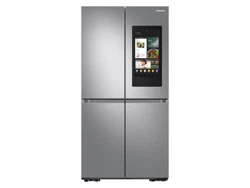Documents: Go to download!
User Manual
- User Manual - (English, French, Spanish)
- Energy Guide - (English)

- Installation
- Operations
- Maintenance
- Troubleshooting
Table of contents
User manual Refrigerator
Installation
Follow these instructions carefully to ensure a proper installation of this refrigerator and to prevent accidents before using it.
Refrigerator at a glance
The actual refrigerator and provided component parts of your refrigerator may differ from the illustrations in this manual, depending on the model and the country.
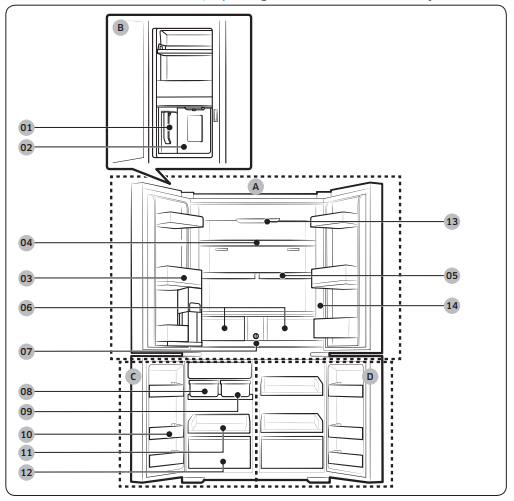
01 AutoFill pitcher
02 Water dispenser
03 Fridge door bin
04 Fridge shelf
05 Quick Space shelf
06 Crisper+ / Flex Crisper
07 Water filter
08 Auto ice maker - Cubed Ice
09 Auto ice maker - Ice Bites
10 Freezer door bin
11 Freezer shelf
12 Freezer drawer
13 UV Deodorizing Filter
14 Control panel
A. Fridge
B. Beverage Center
C. Freezer
D. FlexZone
NOTE
- For energy efficiency, keep all shelves, drawers, and baskets in their original positions.
- When closing the door, make sure the vertical hinged section is in the correct position to avoid scratching the other door.
- If the vertical hinged section is reversed, put it back into the correct position, and then close the door.
- Moisture may form at times on the vertical hinged section.
- If you close a door forcefully, the other door may open.
- When a door is opened, the interlock switch automatically disables the auger motor of the ice maker for safety reasons.
- If the internal or external LED lamp is out of order, contact a local Samsung service center.
Door bins
Your refrigerator ships with door bins of different types and sizes. If the door bins for your refrigerator were packaged separately, use the figure below to help you position the bins properly.
NOTE
The actual refrigerator and provided component parts of your refrigerator may differ from the illustrations in this manual, depending on the model and the country.
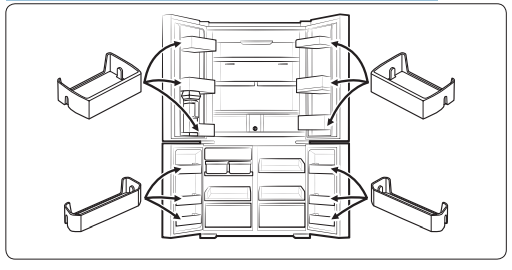
Step-by-step installation
STEP 1 Select a site
The site must:
- Have a solid level surface without carpeting or flooring that may obstruct ventilation
- Be out of direct sunlight
- Have adequate room for opening and closing the door
- Be away from any heat source
- Provide room for maintenance and servicing
- Have a temperature range between 50 °F (10 °C) and 110 °F (43 °C)
Clearance
See the pictures and table below and on the next page for installation space requirements


NOTE
The measurements of your refrigerator may differ from those listed above, depending on the measuring method.
STEP 2 Flooring
If the refrigerator cannot pass through the entrance due to its size, see Door removal for entrance.

NOTE
To prevent floor damage, make sure the front leveling legs are in the upright position.
- The surface you install the refrigerator on must support a fully loaded refrigerator.
- To protect the floor, put a large piece of cardboard along the path to the refrigerator's final installation location.
- Once the refrigerator is in its final position, do not move it unless necessary to protect the floor. If you have to move the refrigerator, place thick paper or cloth such as old carpets along the path of movement.
STEP 3 Door removal for entrance
If the refrigerator cannot pass through the entrance to your home or kitchen due to its size, follow these instructions to remove and then re-install the refrigerator's doors. If you do not need to remove the doors, go to page 31 to continue the installation procedure.
WARNING
Unplug the power cord of the refrigerator before removing the doors.
Tools required (not provided)

Detach the fridge doors
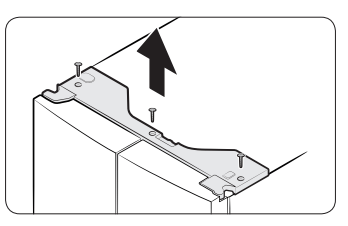
1. With the doors closed, use a Phillips screwdriver to remove the screws (x3) from the top cover. Pull up and remove the top cover with the connectors.
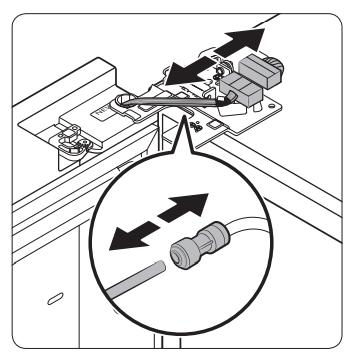
2. Disconnect the two wire connectors on the left door. The position of the connectors differs with the model.
CAUTION
- Do not remove both doors simultaneously. Make sure to remove one door at a time. Otherwise, any of the doors may fall and cause physical injury.
- Make sure the refrigerator is off before disconnecting the connectors.
3. Disconnect the water tube from the coupler on the left door as shown. - This step does not apply to the models without the AutoFill pitcher and the water dispenser.
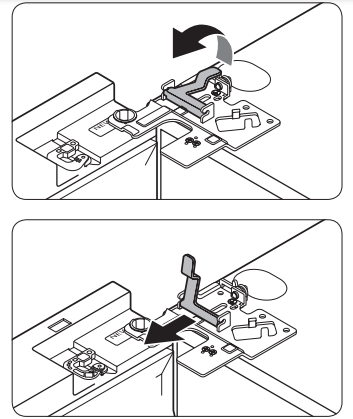
4. Gently draw up the clamp in several steps. To prevent finger injuries, do not apply a sudden force to the clamp.
5. Pull up the clamp to remove.

6. Open the door 90 degrees. While holding the door, pull up and remove the top hinge. Be careful not to damage the connector wires when you remove the hinge.
7. Gently pull up the door vertically to remove. Do not apply excessive force to the door. The door may fall, causing physical injury.
8. Lay the door down on a flat surface.
9. Repeat steps 1-8 for the other door, except for step 3. There is no water tube on the right side door.
- Step 2 does not apply to the models without the Showcase door.
Detach the freezer doors
CAUTION
- Be sure to remove the fridge doors before removing the freezer doors.
- Use caution when disconnecting the bottom connectors.
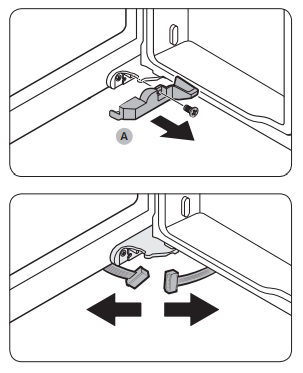
1. Open the freezer door.
2. Use a Phillips screwdriver to remove the screw holding the cover (A).
- This step only applies to the right side freezer door (FlexZone door).
3. Disconnect the wire connectors.

- This step only applies to the right side freezer door (FlexZone door).
4. Locate the hinge shaft. While holding the door with one hand, use a flat-head screwdriver or Allen wrench to press the shaft down. Make sure to hold the door to prevent the door from falling.
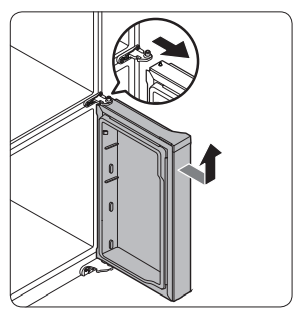
5. To prevent contact with the middle hinge, slightly tilt the door to the front, and then lift it up to remove.
6. Repeat steps 1-5 for the other door, except for steps 2 and 3.
To reattach the freezer doors
CAUTION
- The freezer doors must be re-attached before the fridge doors.
- Be careful not to damage or step on the wires during this process.

1. Insert the freezer door into the bottom hinge while pushing the freezer door in the direction of the arrow.
CAUTION
- Be careful not to damage or step on the wires during this process.
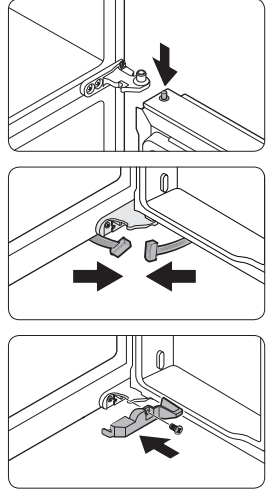
2. While pressing the hinge shaft down, position the door so that the hinge shaft is below the shaft hole in the middle hinge. Release the hinge shaft so that it enters the shaft hole.
3. With the door open, connect the bottom connectors in the direction of the arrows.
- This step only applies to the right side freezer door (FlexZone door).
4. Attach the cover using a Phillips screwdriver. Be careful not to damage or step on the connectors.
- This step only applies to the right side freezer door (FlexZone door).
5. Repeat steps 1-5 for the other door, except for steps 3 and 4
To reattach the fridge doors
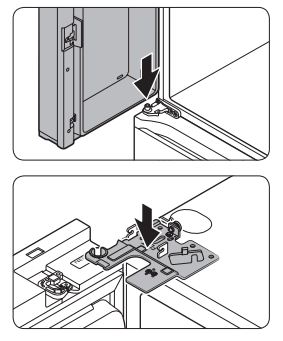
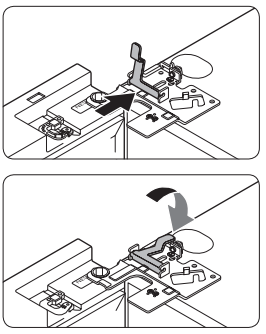
1. While holding the door open by more than 90 degrees, insert the shaft on the middle hinge into the hole on the bottom of the door.
2. Put the top hinge into position on the top of the refrigerator, and then insert the hinge shaft into the top hole of the door. Make sure the wires from the door pass through the hole in the hinge shaft.
3. Insert the clamp in the direction of the arrow.
4. Push back the clamp as shown.
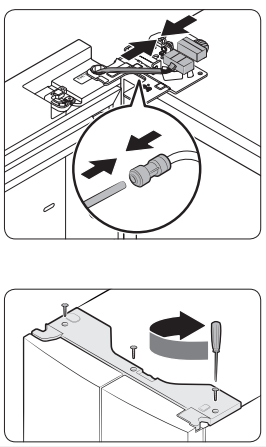
5. Connect the wire connectors.
CAUTION
Make sure the wire connectors are connected properly. Otherwise, the display will not operate.
6. Connect the water tube.
- This step does not apply to the models without the AutoFill pitcher and the water dispenser.
CAUTION
- To prevent water leaks, make sure the red clips tighten the coupler properly.
- Keep the clips out of children’s reach.
7. Repeat steps 1-5 for the other door.
- Step 5 does not apply to the models without the Showcase door.
8. Attach the top cover with the front side first, and then press down on its back to get it into position. Then, tighten the screws (x3).
STEP 4 Leveling the refrigerator
CAUTION
- When installed, the refrigerator must be leveled on a flat, solid floor. Not leveling the refrigerator can cause damage to the refrigerator or physical injury.
- Leveling must be performed with the refrigerator empty. Make sure no food items are inside the refrigerator.
- For safety reasons, adjust the front a little higher than the rear.
Level the refrigerator using the special screws (levellers) on the front legs. Use a flat-head screwdriver to turn the levellers.

- To adjust the height of the left side: Insert a flat-head screwdriver into the leveller of the left side front leg. Turn the leveller clockwise to raise the left side or turn it counterclockwise to lower.
- To adjust the height of the right side: Insert a flat-head screwdriver into the leveller of the right side front leg. Turn the leveller clockwise to raise the right side or turn it counterclockwise to lower.
STEP 5 Adjust the door height
Adjusting the height with the height lever (applicable models only)
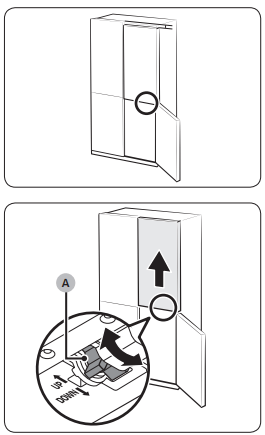
- Before aligning the door height, make sure the refrigerator is level. Use the leveling legs for this purpose.
- You can use the height lever at the bottom of the right-side door of the fridge. Open the right-side door of the freezer with both fridge doors closed and use the lever to adjust the door height.
- Turn the height lever (A) until the two doors are aligned at the top. Turn the lever toward UP (as marked) to raise the right-side door and turn it toward DOWN (as marked) to lower the door.
- Lift the fridge door slightly to make alignment easier. The maximum adjustable height is 3 mm.
- The lever will not turn past the maximum limit. It may make a noise it if is turned too far.
- Excessive height may interfere with the upper hinge cover of the fridge door.
- If you align the door height with the door bins empty and then store items in the bins, the heights may differ again. If this happens, follow the steps above to realign the doors.
Adjusting the height with the snap rings
For the models with the height lever on the right-side door of the fridge, use the snaps rings only if you cannot align the doors with the height lever.
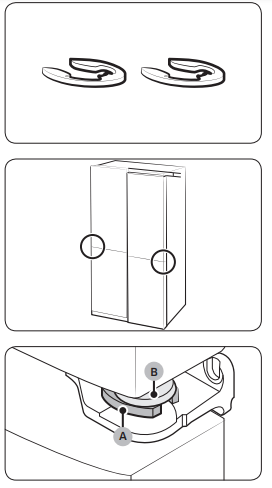
NOTE
The height of a door can be adjusted using the provided snap rings, which come in 4 different sizes (1 mm, 1.5 mm, 2 mm, and 2.5 mm).
1. Check the height difference between the doors, and then lift up and hold the door with the lower height.
2. Insert a suitable-sized snap ring (A) between the door grommet (B) and the hinge as shown.
CAUTION
- Insert only one snap ring. If you insert two or more snap rings, the rings may slip out or make a rubbing noise.
- Keep the snap rings out of children’s reach and keep them for future use.
- Do not raise the door too much. The door can contact and damage the top cover.
Adjusting the freezer door height (applicable models only)
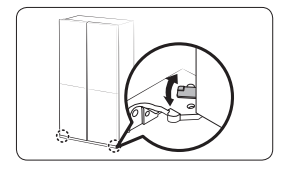
- Before aligning the door height, make sure the refrigerator is level. Use the leveling legs for this purpose.
- You can adjust the height of both freezer doors using the lever located at the bottom hinge.
- Open the door, lift it a little, and then turn the lever left or right to adjust the height.
Adjusting the gap between the fridge doors and the main body of the refrigerator (applicable models only)
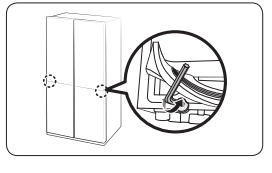
- You can adjust the gap between both fridge doors and the main body of the refrigerator using the adjustment bolt located at the bottom of the fridge compartment.
- Lift the door gasket and located the adjustment bolt underneath the gasket. Use the 4 mm Allen wrench to adjust the gap.
CAUTION
Make sure you firmly attach the gasket. Otherwise, cold air from the refrigerator may leak.
Adjusting the gap between the doors and the main body of the refrigerator (applicable models only)
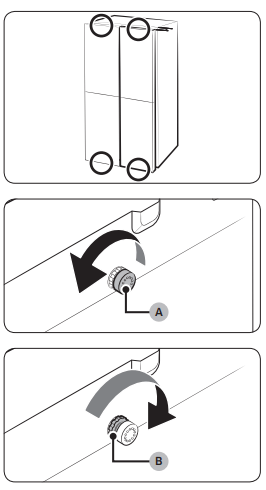
You can adjust the gap between all four doors and the main body of the refrigerator using the adjustment dial. (Refer to the figure for the location of the adjustment dial.)
1. Open the door that is closer to the main body than the others. Then, turn the adjustment dial (A) counterclockwise until the gap becomes even with the others.
2. After adjusting the gap, turn the locking nut (B) to lock the adjustment dial.
NOTE Each time you turn the adjustment dial, the gap is adjusted by 1 mm. However, the door may not close properly if you adjust the door by more than 1.5 mm.
STEP 6 Connect the water dispenser line
A water dispenser with a filter is one of the helpful features on your new refrigerator. To help promote better health, the water filter removes unwanted particles from your water. However, it does not sterilize or destroy microorganisms. You may need to purchase a water purifying system to do that.
The water line also connects to the ice maker. For the ice maker to operate properly, water pressure must be between 30-125 psi (206-861 kPa).
If the refrigerator is installed in an area with low water pressure (below 30 psi / 206 kPa), you can install a booster pump to compensate for the low pressure. After you have connected the water line, check if the water dispenser works properly. Press the water dispenser lever until the water runs from the water outlet.
NOTE
• Water line installation kits are available at extra cost from your retailer. We recommend using a water line installation kit that contains copper tubing and a 1/4" (6 mm) compression nut.
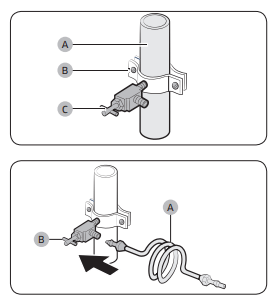
1. Shut off the main water source.
2. Insert the pipe clamp (B) and the shutoff valve (C) into the cold water line (A).
3. Connect the water line installation kit (A) to the shutoff valve (B).
Connect the water supply line to the refrigerator
There are several items you must purchase to complete this connection. You may find these items sold as a kit at your local hardware store.


A. Refrigerator
B. Household water supply line
C. Water Line: must be kept straight.
01 Compression Nut (1/4") (Assembled)
02 Ferrule (Not supplied)
03 Copper tubing (Not supplied)
04 Plastic Tubing (Assembled)
05 Compression Fitting (Assembled)
06 Molded end (Bulb)
07 Compression nut (B) (1/4") (Not supplied)
08 Plastic Tubing (A) (Not supplied)
NOTE
If you have to relocate the refrigerator after connecting the water line (C), make sure the joined section of the water line is straight.
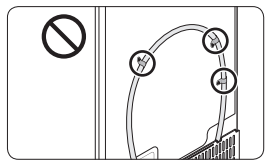
1. Connect the household water line to the assembled compression fitting.
- If you are using copper tubing, slip the compression nut (B) (not supplied) and ferrule (not supplied) on the copper tubing (not supplied) as shown.
- If you are using plastic tubing (A), insert the molded end (Bulb) of the plastic tubing (A) into the compression fitting.
CAUTION
- If you use plastic tubing (A), do not use it without the molded end (Bulb).
- Leaving the water line disconnected may cause the water valve to produce a buzzing sound over time. If this is the case, make sure that the ice making function is turned “OFF” and do not attempt to use the water dispenser
2. Tighten the compression nut (B) onto the compression fitting. Do not over-tighten the compression nut (B).
3. Turn the water on and check for any leakage. If you find water drops or leakage in the connection areas, turn off the main water supply. Check the connections and, if necessary, tighten.
4. Flush 3 gallons of water through the filter before drinking or using the water from the refrigerator. (Flush approximately 5-6 minutes.) To flush, press a large glass or cup against the water dispenser lever. Fill the glass, empty it, and then repeat.
5. After you turn on the refrigerator, let the ice maker make ice for 1 to 2 days. Over that period of time, throw out the first 1 or 2 buckets of ice the ice maker makes to ensure all impurities have been removed from the water line.
NOTE
Only connect the water line to a potable water source.
- If you have to repair or disassemble the water line, cut off 1/4“ of the plastic tubing to make sure you get a snug, leak-free connection.
- You can test the water line quickly using a paper cup. Under normal conditions, the water dispenser can fill a 5 3/4 oz. (170 cc) cup in about 10 seconds.
STEP 7 Initial settings
By completing the following steps, the refrigerator should be fully functioning.
- Plug the power cord into the wall socket to turn the refrigerator on.
- Open the door, and check if the interior light lights up.
- Set the temperature to the coldest setting, and wait for about an hour. Then, the freezer will be slightly chilled, and the motor should be running smoothly.
- Wait until the refrigerator reaches the set temperature. Now the refrigerator is ready for use.
STEP 8 Final check
When installation is complete, confirm that:
- The refrigerator is plugged into an electrical outlet and grounded properly.
- The refrigerator is installed on a flat, level surface with a reasonable clearance from walls and cabinets.
- The refrigerator is level and is sitting firmly on the floor.
- The door opens and closes freely, and the interior light turns on automatically when you open the door
Operations
User interface
NOTE
- For more information about other menus and apps available on the Refrigerator app. See the Online manual of your refrigerator.
- The content of apps and widgets, or their design is subject to change or support may be discontinued without notice, depending on the content provider’s policy.
- Children's use of the refrigerator's functions, apps, and services must be supervised by adults.
- Underage transactions with the services must be supervised by adults.
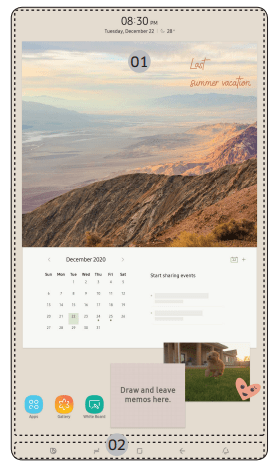
01 Home screen
02 Soft buttons
01 Home screen
- Tap a desired app or widget to launch it.
- On the home screen, you can add or remove items such as apps, widgets, pictures, videos, drawings, and texts.
- Tap and hold an item to enter Edit mode. In Edit mode, you can drag and drop an item to a new location on the home screen. When you move the item to a new location, the item turns red if the location is not available.
02 Soft buttons

01 Bixby
- Tap to use Bixby.
02 Task Manager
- Tap to open the Task Manager.
03 Home
- Tap to open the Home screen.
04 Return
- Tap to return to the previous screen.
05 Notification
- Tap to display the Quick Panel.
06 Hide/Show
- Tap to hide or show Soft buttons.
- The Hide/Show button only appears when an app is active.
Fridge Manager
On the Home screen, tap the Fridge Manager app.
- You can set the desired temperature or modes for each compartment.
- For more detailed information on the Fridge Manager app, check the online manual.
- To access the online manual from your Family Hub refrigerator, tap Setting > Help & Contact Us > Online Manual.
Display reset (applicable models only)
If you encounter an abnormal symptom on the display, try resetting the display. This may solve the symptom.
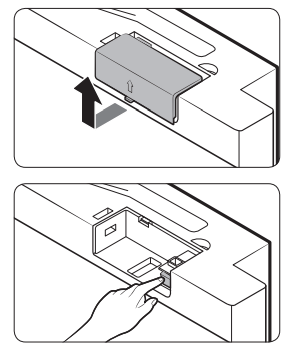
1. Open the fridge door and locate the switch cover on the top right corner of the door.
2. Push up the cover to reveal the power switch.
3. Turn the switch off and turn it on again.
4. Reinsert the switch cover to the end until you hear a clicking sound.
SmartThings
Installation
Visit the Google Play Store, Galaxy Apps, or Apple App Store and search for “SmartThings”. Download and install the SmartThings app provided by Samsung Electronics to your smart device.
NOTE
- The SmartThings app is designed for Android 7.0 (Nougat) or later, iOS 12.0 or later, iPhone 6 or later, and is optimized for Samsung smartphones (Galaxy S and Galaxy Note series).
- For improved performance, the SmartThings app is subject to change without notice, or discontinued support according to the manufacturer’s policy.
- Recommended encryption systems include WPA/TKIP and WPA2/AES. Any newer or unstandardized Wi-Fi authentication protocols are not supported.
- Wireless networks may be affected by the surrounding wireless communication environment.
- If your Internet service provider has registered the MAC address of your PC or modem for identification, your Samsung Smart Refrigerator may fail to connect to the Internet. If this happens, contact your Internet service provider for technical assistance.
- The firewall settings of your network system may prevent your Samsung Smart Refrigerator from accessing the Internet. Contact your Internet service provider for technical assistance. If this symptom continues, contact a local Samsung service center or retailer.
- To configure the wireless access point (AP) settings, see the user manual of the AP.
- Samsung Smart Refrigerators support both Wi-Fi 2.4 GHz with IEEE 802.11 b/g/n and Soft-AP protocols (IEEE 802.11 n is recommended).
- Unauthorized Wi-Fi wireless routers may fail to connect to applicable Samsung Smart Refrigerators.
Special features
Water pitcher (Autofill Pitcher) (applicable models only)
Cold, purified water is always ready in the AutoFill Pitcher. You can put tea or fruits in the infuser to enjoy the various infused water you like.

01 Lid
02 Infuser holder
03 Infuser
04 Body
To fill the Water pitcher
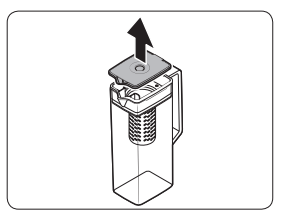
1. Grasp a handle groove of the lid, and then pull up to open the lid.
2. Put tea leaves or fruit to your taste into the infuser.
NOTE If you want to keep the infused water in its initial concentration, turn the Autofill Pitcher function off.
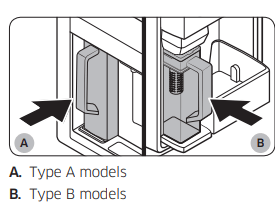
3. Enable the Autofill Pitcher function on the control panel. Open the Beverage Center door (Type A) or the left door of the fridge (Type B), and then mount the water pitcher onto the holder. Push it straight in as shown in the figure.
CAUTION
Make sure the water pitcher fits in the water pitcher holder.
4. Close the door. The water pitcher will start to fill with chilled water a short time later.

5. To drink tea, open the Beverage Center door (Type A) or the left door of the fridge (Type B), and then detach the water pitcher. Pull it straight out.
CAUTION
- We recommend consuming fruit infused water within 24 hours. After that, the infused water can spoil over time.
- You must clean the water pitcher after you have consumed the infused water. Also clean the water pitcher if you haven't used it for a long time.
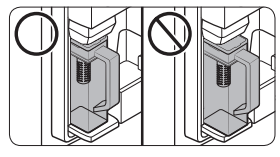
- • To prevent the water pitcher from tipping over or leaking, make sure the water pitcher fits in the water pitcher holder.
- To prevent the water pitcher from spilling over or leaking, make sure the infuser holder is properly inserted.
 N
N
OTE
- If the front side (specifically marked area) of the water pitcher has too much moisture, the water pitcher may not fully fill. Remove the moisture, and then try again.
- Autofill Pitcher function will stop supplying water to the water pitcher if the water pitcher does not fill after a certain amount of time. If this happens, check if the water line is properly connected. Remove and reinsert the water pitcher, and then try again.
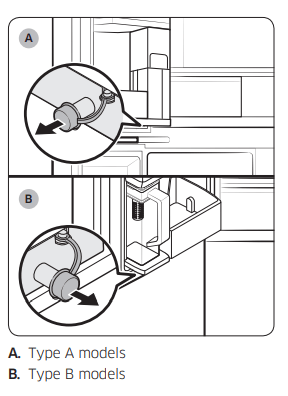
NOTE
- Wipe around the water pitcher holder if the water pitcher overflows or leaks.
- Water drops off if the rubber cap is opened.
- An alert message appears on the control panel if there is a leak. In case of a leak, open the rubber cap so that the leaked water drains. If the alert message does not disappear after draining, there might be a system failure. Contact your local Samsung service center.
Water dispenser (applicable models only)

To dispense chilled water, open the Beverage Center and press the dispenser lever.
NOTE
- The dispenser will stop dispensing if you keep pushing the dispenser lever for about 1 minute. To dispense more water, release and push the lever again.
- Make sure the glass is in line with the dispenser to prevent the dispensed water from spilling out.
- If you do not use the water dispenser for 2-3 days, the dispensed water may have an abnormal smell or taste. This is not a system failure. Discard the first 1-2 glasses of water.
Water clouding
Water supplied to the refrigerator flows through a core alkaline filter. During this filtering process, the water pressure of the water increases and the water becomes saturated with oxygen and nitrogen. This causes the water to look misty or cloudy temporarily when dispensed. This is normal and the water will look clear after a few seconds.
Ice maker
The refrigerator has a built-in ice maker that automatically dispenses ice.

- The overall design and/or accessories may differ with the model.
- This product has two types of ice makers.
Ice making
After you have installed your refrigerator and plugged it in, follow these instructions to ensure proper ice making and to keep the ice bucket full of ice.
For first-time use
- Let the ice maker make ice for 1-2 days.
- Discard the first 1-2 buckets of ice to remove impurities in the water supply system.
Diagnosis

- The overall design and/or accessories may differ with the model.
- If ice does not dispense, first check the status of ice maker using the Test button on the bottom of the ice maker.
- Press the Test button on the bottom of the ice maker. You will hear a chime (ding-dong) when you press the button. You will hear another chime if the ice maker is operating properly.
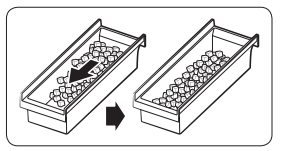
- Ice accumulating on one side of the tray is normal. Arrange the ice evenly in the tray to store more ice.
CAUTION
- Leaving the water line disconnected may cause the water valve to produce a buzzing sound over time. If this is the case, make sure to turn the ice making function (Cubed Ice / Ice Bites ) off.
- If the ice making chime rings repeatedly, contact the waterline installer or a local Samsung service center.
- Do not put food in the ice bucket. The frozen food may damage the ice maker, especially when you open or close the door.
- When the refrigerator recovers power after a power failure, the ice bucket may contain a mix of melted and jammed ice cubes, which can prevent the ice maker from working properly. To prevent this, make sure to empty the ice bucket before using the refrigerator.
- Do not put fingers or any objects into the ice maker. This can cause physical injury or property damage.
- Due to sublimation, ice stored in the freezer for a long time gets smaller and then forms large ice chunks. Therefore, if it will be a long time before you use ice, turn the ice maker off as follows.
- Use the new hose-sets supplied with the appliance only. Do not re-use an old hose set.
Maintenance
Handling and care
Ice bucket (applicable models only)
If you do not dispense ice for an extended period, ice may form clumps inside the bucket. If this happens, remove and empty the ice bucket.
CAUTION
- To prevent injury, make sure to clean up any ice or water that has fallen on the floor.
- To prevent accidents or injury, do not let children play with the water dispenser or the ice maker.
- Use only the provided ice bucket. Third-party ice buckets may cause a system failure.
NOTE
- The water pressure required for ice making is between 20 psi and 125 psi (138 and 862 kPa).
- Noise from the ice maker as it produces ice during the ice making process is normal.
Autofill pitcher (applicable models only)

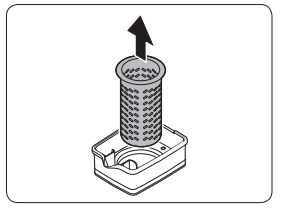
1. Grasp a handle groove of the lid, and then pull up to remove.
2. Grasp both sides of the infuser holder, and then lift to remove.
3. While slightly twisting the infuser, pull it out of the sealed mouth.
4. Clean the infuser with neutral agents and running water. Rinse and dry well.
5. Reassemble the Autofill pitcher in the reverse order of disassembly.
CAUTION
The water pitcher and lid are not dishwasher and microwave safe and can melt or deform if exposed to heat (including hot water). Please hand wash in cool or warm water as needed.
Fridge shelves
The appearance of the shelves differs by model

- To remove a shelf, fully open the corresponding door. Hold the front of the shelf, and then gently lift up and pull out.
NOTE
Do not lift up the shelf fully when removing or reinserting the shelf. The rear wall of the fridge room can be dented.
- To reinsert, hold the shelf at an angle so the front is higher than the back, and then insert the top hook into the top shelf notch. Then, lower the shelf and insert the bottom shelf hook into the bottom shelf notch.
CAUTION
- The tempered glass shelves are heavy. Use caution when removing them.
- The shelf must be inserted correctly. Do not insert upside down.
- Glass containers may scratch the surface of glass shelves.
Door bins
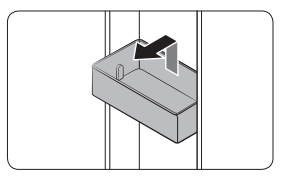
- To remove the door bin, hold the front sides of the bin, and then gently lift up to remove.
- To reinsert, insert the door bin slightly above its final location making sure that the back of the bin is against the door. Hold the rear of the door bin with both hands, and then press down so that it fits snugly.
CAUTION
- Do not remove a bin that is filled with food. Empty the bin beforehand.
- Use caution when opening the door if the bottom bin contains larger bottles, which may fall over.
- Do not allow children to play with the bins. Sharp corners of the bin may cause injury
Fridge drawers
Crisper+ / Flex Crisper

Gently lift up the front of the drawer and slide out.
- We recommend that you remove the door bins before removing the drawer. This is to prevent damage to the door bins.
- To reinsert, insert the drawer into the frame rails and then slide inward.
Cleaning
Interior and exterior
WARNING
- Do not use benzene, thinner, home/car detergent, or Clorox™ to clean the refrigerator.
- They may damage the surface of the refrigerator and cause a fire.
- Do not spray water onto the refrigerator. This may cause electric shock.
Regularly use a dry cloth to remove all foreign substances such as dust or water from the power plug terminals and contact points.
- Unplug the power cord.
- Use a moistened, soft, lint-free cloth or paper towel to clean the refrigerator’s interior and exterior.
- When done, use a dry cloth or paper towel to dry well.
- Plug in the power cord.
Dispenser valve (applicable models only)
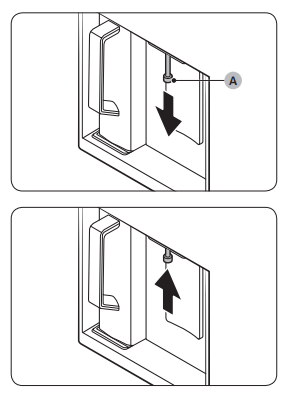
1. Hold the end of the dispenser valve (A).
2. While turning the dispenser valve (A) left, pull it down to remove it from the dispenser.
3. Clean the dispenser valve thoroughly, and then assemble it back.
CAUTION
• Fully insert the dispenser valve, so it is back to its original position.
• Do not use a sponge with rough textures for cleaning the dispenser valve.
Rubber seals
If the rubber seals of a door become dirty, the door may not close properly and reducing refrigerator performance and efficiency. Use a mild detergent and damp cloth to clean the rubber seals. Then, dry well with a cloth.
Rear panel
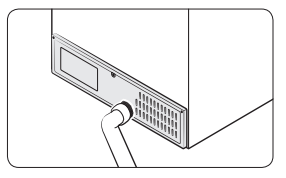
To keep cords and exposed parts of the rear panel free of dirt, vacuum the panel once or twice a year.
Water filter


- Shut off the water supply line.
- Open the filter cartridge cover.
- Turn the knob of the filter cartridge counter clockwise 90 degrees (1/4 turn). The filter cartridge unlocks.
- Pull out to remove the cartridge.
- If the water filter is severely contaminated, the cartridge may not be easy to remove. If that is the case, use force to remove the cartridge.
- To prevent water leaks from the filter opening, pull the cartridge straight out while removing it.
- Insert a new filter cartridge. Use onl Samsung-provided or approved filters.
- Turn the cartridge knob clockwise to lock into place.
- Close the filter cartridge cover.
- On the Home screen, tap Fridge Manager > Fridge Settings > Water Filter, and then select Reset.
NOTE
- A newly installed filter may cause the water dispenser to spurt water briefly. This is because air has entered the waterline.
- The replacement process may cause the water dispenser to drip for a short period of time. If it drips, simply wipe up any water on the floor with a dry towel.
Reverse osmosis water filtration system
The water pressure of the water supply system to a reverse osmosis water filtration system must be between 30-125 psi (206-861 kPa).
The water pressure of the reverse osmosis water filtration system to the refrigerator’s cold water line must be at least 30 psi (206 kPa). If the water pressure is below these specifications:
- Check if the sediment filter in the reverse osmosis system is blocked. Replace the filter if necessary.
- Refill the water tank in the reverse osmosis system with water.
- If your refrigerator has a water filter, it may further reduce the water pressure when used in conjunction with a reverse osmosis system. Remove the water filter.
For more information or servicing, contact a licensed plumbing professional.
Ordering a new filter
To purchase a new water filter, contact a local Samsung service center or visit www. samsungparts.com on the web.
LED Lamps
To replace the lamps of the refrigerator, contact a local Samsung service center.
Troubleshooting
Before calling for service, review the symptoms and recommended solutions below. If none of the suggested solutions resolve your problem, please visit our website at www. samsung.com or call Samsung Customer Care at 1-800-SAMSUNG (726-7864). Note that you will be charged for any service visits in which no defects were found.
Temperature
Fridge/freezer does not operate. Fridge/freezer temperature is warm.
Possible causes:
- Power cord is not plugged in properly.
- Temperature control is not set correctly.
- Refrigerator is located near a heat source or direct sunlight.
- Not enough clearance between refrigerator and nearby walls or cabinets.
- The refrigerator is overloaded. Food is blocking the refrigerator vents.
Solution:
- Properly plug in the power cord.
- Set the temperature lower.
- Keep the refrigerator away from direct sunlight or a heat source.
- Make sure there is a gap of at least 2.5 inches (5 cm) between the refrigerator back and sides and any nearby walls or cabinets.
- Do not overload the refrigerator. Do not allow food to block vents.
Fridge/freezer is over-cooling.
Possible causes:
- Temperature control is not set correctly.
Solution:
- Set the temperature higher.
Interior wall is hot.
Possible causes:
- Refrigerator has heat-proof piping in the interior wall.
Solution:
- To prevent condensation from forming, the refrigerator has heat-proof piping in the front corners. If the ambient temperature rises, this equipment may not work effectively. This is not a system failure.
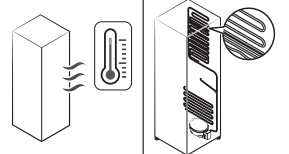
Odors
Refrigerator has odors.
Possible causes:
- Spoiled food.
- Food with strong odors.
Solution:
- Clean the refrigerator and remove any spoiled food.
- Make sure strong smelling food is wrapped airtight.
Frost
Frost around the vents.
Possible causes:
- Food is blocking the vents.
Solution:
- Make sure no food blocks the refrigerator vents.
Frost on interior walls.
Possible causes:
- Door is not closed properly.
Solution:
- Make sure food does not block the door. Clean the door gasket.
Condensation
Condensation forms on the interior walls.
Possible causes:
- If door is left open, moisture enters the refrigerator.
- Food with high moisture content.
Solution:
- Remove the moisture and do not leave a door open for extended periods of time.
- Make sure food is wrapped airtight.
Water/ice (dispenser models only)
Water flow is weaker than normal.
Possible causes:
- Water pressure is too low.
Solution
- Make sure the water pressure is between 30 to 120 psi (206 to 827 kPa).
Ice maker makes a buzzing sound.
Possible causes:
- The Ice Maker function is activated, but the water supply to the refrigerator has not been connected.
Solution
- Press Ice Maker.
Ice maker does not make ice.
Possible causes:
- Ice maker has just been installed.
- Freezer temperature is too high.
- Dispenser panel Lock is activated.
- Ice maker is off.
Solution:
- You must wait for 12 hours for the refrigerator to make ice.
- Set the freezer temperature below 0 °F (-18 °C) or -4 °F (-20 °C) in warm ambient air.
- Deactivate dispenser panel Lock.
- Turn on the ice maker.
Ice does not dispense.
Possible causes:
- Ice may jam if the ice dispenser is not used for a long time (approx. 3 weeks).
- Ice bucket is not properly inserted.
- Water line is not connected properly or water supply is not on.
Solution:
- If you won't be using the refrigerator for a long time, empty the ice bucket and turn off the ice maker.
- Make sure the ice bucket is properly inserted.
- Check if the water line is installed correctly. Check if the water line stop cock is closed.
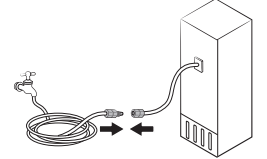
Water does not dispense.
Possible causes:
- Water line is not connected properly or water supply is not on.
- Dispenser panel Lock is activated.
- A third-party water filter was installed.
- Water filter indicator turns on or blinks.
Solution:
- Check if the water line is installed correctly. Check if the water line stop cock is closed.

- Deactivate dispenser panel Lock.
- Use only Samsung-provided or approved filters.
- Unapproved filters may leak and damage the refrigerator.
- Replace the water filter. After replacing, reset the filter indicator sensor.
Do you hear abnormal sounds from the refrigerator?
These sounds are normal.
- When starting or ending an operation, the refrigerator may make sounds similar to a car engine ignition. As the operation stabilizes, the sounds will decrease.

- While the fan is operating, these sounds may occur. When the refrigerator reaches the set temperature, the fan sound will stop.

- During a defrost cycle, water may drip on the defrost heater, causing sizzling sounds.

- As the refrigerator cools or freezes, refrigerant gas moves through sealed pipes, causing bubbling sounds.

- As the refrigerator temperature increases or decreases, plastic parts contract and expand, creating knocking noises. These noises occur during the defrosting cycle or when electronic parts are working.

- For ice maker models: When the water valve opens to fill the ice maker, you may hear a buzzing sound.
- Due to pressure equalizing when you open and close the refrigerator door, you may hear a whooshing sound.
SmartThings (Symptom > Action)
Could not find “SmartThings” in the app market.
- The SmartThings app is designed for Android 7.0 (Nougat) or later, iOS 12.0 or later, iPhone 6 or later, and is optimized for Samsung smartphones (Galaxy S and Galaxy Note series).
The SmartThings app fails to operate.
- The SmartThings app is available for applicable models only.
- The old Samsung Smart Refrigerator app cannot connect with Samsung Smart Home models.
The SmartThings app is installed but is not connected to my refrigerator.
- You must log into your Samsung account to use the app.
- Make sure that your router is operating normally.
- • If you have not connected your refrigerator to the SmartThings App after the app was installed, you must make the connection using the device registration function of the app.
Could not log into the app.
- You must log into your Samsung account to use the app.
- If you don’t have a Samsung account, follow the app’s onscreen instructions to create one
. An error message appears when I try to register my refrigerator.
- Easy Connection may fail due to the distance from your access point (AP) or electrical interference from the surrounding environment. Wait a moment and try again.
The SmartThings app is successfully connected to my refrigerator but does not run.
- Exit and restart the SmartThings app, or disconnect and reconnect the router.
- Unplug the power cord of the refrigerator, and then plug it in again after 1 minute.
LCD (Symptom > Action)
Cannot connect to my TV.
• This refrigerator can connect only with Samsung Smart TV 6400 series or higher models released since 2015. Please check the model name of your TV first.
• Network connections may suffer temporary interruptions. Turn your TV off, and then try again.
The inner view picture looks bulged out or incomplete.
• The edges of the inner view may look bulged out. The bulging is caused by the convex lens of the camera.
• The inner view may be incomplete due to the blind spots on the left and right corners or screened depending on the layout of food items. Make sure to place food items in the front center.
The displayed measurement on the Fridge Manager is not correct.
• The displayed conditions may differ from the actual temperature and humidity.
Smart Grid (applicable models only) (Symptom > Action)
What Do I Need to use the Energy Management and Smart Grid functions?
To use the Smart Grid (Demand Response) and Energy Management functions on your refrigerator, you need the following:
Devices
- A wireless access point (router)
- A Samsung Energy Management-supported refrigerator
- A smartphone
Registration
- Connect your refrigerator to your home Wi-Fi network.
- Register for the EMS service with your electric company. Your electric company must have an EMS (Energy Management System) supporting SEP (Smart Energy profile).
App
- Download the SmartThings app from the Google Play Store, Apple App Store, or Samsung Galaxy Apps.
- Install and run the SmartThings app on your smartphone
Why isn’t the Energy Management function working normally?
- Make sure that your home router is operating normally with proper Internet service and connection.
- Make sure that the refrigerator is connected to the AP (router).
Checkpoints
- Connect your smartphone to the router (AP, Access Point), and then check if you can browse the Internet on the smartphone
Why isn’t the Delay Defrost Capability working normally?
- Make sure that your home router is operating normally with proper Internet service and connection.
See other models: RF29A9771SR/AA RB12A300635/AA SM-G973UZWECHA WD90TA046BE/EU SM-T395NZKABTU
